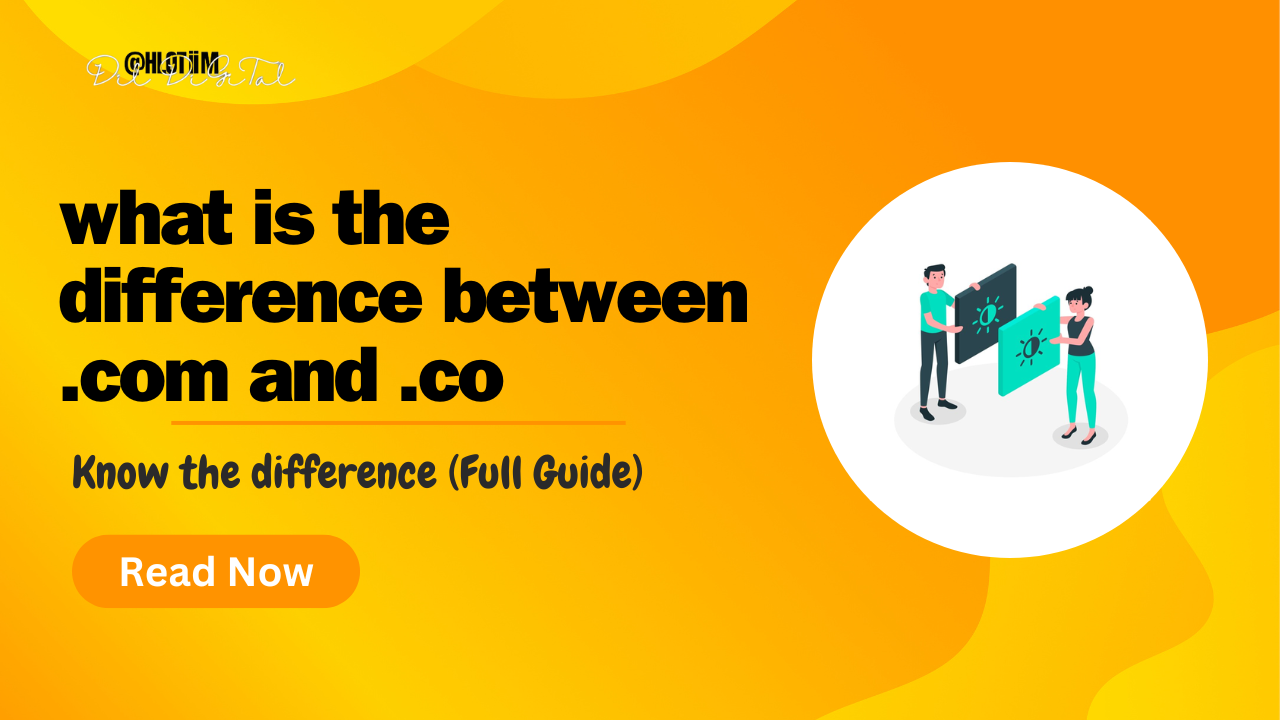When it comes to building an online presence, few decisions are more crucial than your domain name. At the heart of that choice lies the domain extension (also known as the Top-Level Domain or TLD).
Two extensions that frequently enter the debate are .com and .co. But how do these two stack up against each other, and which is the right fit for you?
In this article (what is the difference between .com and .co by dil digital), we’ll take a friendly deep dive into the differences between .com and .co, exploring everything from their histories to their impact on branding, SEO, and business credibility.
In this post, we cover...
ToggleWhat is the difference between .com and .co
The difference between .com and .co is that .com is international domain extension where .co is country level domain extention
Domain names are like virtual street addresses for your website, guiding visitors right to your front door in the digital world. Extensions, such as .com and .co, form a crucial part of these web addresses.
When building a brand, you might find yourself wondering: which extension better suits my goals?
Is .com the safer, more traditional route, or can .co provide a modern, innovative edge? By the end of this article, you’ll have a clearer picture of which extension fits your specific needs and how they can influence your brand image, marketing strategies, and online success.
Lets learn What is the difference between.com and.co in details in this article by Dil Digital.
What Are Domain Extensions?
A domain extension, also called a TLD (Top-Level Domain), is the suffix found at the end of a website address. It’s what comes after the dot in your URL. Extensions can be generic (like .com, .net, .org) or country-specific (like .us, .co.uk, .au).

They serve as a first impression of your site’s identity and purpose. For example, .org domains often suggest a non-profit organization, while .edu indicates an educational institution.
TLD vs. ccTLD
TLDs (Top-Level Domains) are generic domain extensions like .com, .net, and .org, which are not tied to any specific country.
ccTLDs (Country-Code Top-Level Domains) are two-letter extensions such as .us, .uk, or .co, and are designated for a particular nation or territory.
While TLDs typically have a global scope, ccTLDs can help businesses establish a local identity or target a specific regional audience.
TLD (Top-Level Domain)
A TLD is the highest level of the domain name system. Generic TLDs (gTLDs) include extensions like .com, .net, and .org. These were initially meant for specific types of organizations, but over time, these distinctions have blurred.
Now, .com is no longer strictly for commercial entities—anyone can register a .com domain.
ccTLD (Country-Code Top-Level Domain)
ccTLDs are two-letter extensions designated to specific countries or territories, such as .uk for the United Kingdom, .au for Australia, or .ca for Canada. They can help businesses target local audiences and establish a clear geographic identity.
However, some ccTLDs, like .co (originally assigned to Colombia), have evolved beyond their geographic roots, becoming globally recognized TLDs in their own right.
The .com Domain
The .com domain, originally intended for commercial entities, has evolved to become the most widely recognized extension worldwide.
Its familiarity and long-standing history often give websites that use .com an added layer of trust and credibility.
Because .com domains are in such high demand, finding an available, memorable name can sometimes be challenging and expensive.
Brief History of .com
When the internet started commercializing in the 1980s, .com was introduced for “commercial” entities. Over time, it became the default extension for businesses worldwide.
Its early popularity means that most single-word, catchy .com domains were snapped up long ago, creating scarcity and adding to its perceived value.
.com Popularity Over Time
Today, .com is almost synonymous with being online. Say “website” to just about anyone, and .com might spring to mind.
This ubiquity provides a built-in layer of trust—people are used to seeing .com, and they tend to trust it almost instinctively. That trust factor has made .com the gold standard for many businesses seeking credibility and recognition.
The .co Domain
Originally designated as the country-code TLD (ccTLD) for Colombia, the .co extension has gained significant global popularity over time.
Many businesses see it as a succinct alternative to .com, thanks to its modern, startup-friendly vibe.
With fewer names already taken compared to .com, .co often offers more availability and fresh branding opportunities.
Brief History of .co
Originally assigned to Colombia as its ccTLD, .co was eventually opened up for global registration. Its adoption skyrocketed when marketers and entrepreneurs realized that “co” could stand for “company,” “corporation,” or “commerce.”
This linguistic flexibility made .co attractive to a broader audience beyond Colombia.
.co in the Modern Digital World
The .co extension has transformed from a small country-code domain into a global brand-friendly TLD. Some well-known platforms and startups have chosen .co to represent “collaboration” or “community,” capitalizing on its short and snappy look.
If you’re a new business seeking something fresh and memorable, .co can be an appealing choice—especially when .com variants are already taken or overpriced.
Key Differences Between .com and .co
The biggest difference is that .com is the older, more recognized extension, carrying a high level of global trust, while .co has a fresher, more modern vibe.
Because .com is in high demand, it can be pricier and harder to acquire, whereas .co is often more available with fewer taken names.
However, some people still confuse .co with .com, so strong branding and communication become crucial for .co owners.
Global Recognition and Credibility
Arguably the biggest difference lies in public perception. .com often carries an immediate sense of legitimacy due to its longstanding presence.
On the flip side, .co—while increasingly recognized—is still seen by some as a lesser-known or “secondary” extension. Yet, many startups love the .co domain for its modern edge.
SEO Implications
From a strict SEO standpoint, search engines don’t inherently favor one extension over another. Both .com and .co are treated similarly in terms of ranking potential. However, user behavior can indirectly affect SEO.
If visitors trust .com more, they might click on it more often in search results, leading to improved metrics like click-through rates.
Yet, if your brand identity resonates strongly with .co—especially if you’re in a tech or creative industry—this might help you stand out in a crowded marketplace.
Pricing
.com domains often come with higher price tags—particularly if the domain name is in high demand. Because so many .coms are taken, you might find yourself paying a premium or having to make do with a less ideal domain name.
In contrast, .co domains can be more readily available, but popular single-word or brandable .co domains can also fetch a premium. Overall, you might find .co to be slightly cheaper upfront but verify renewal costs, which can vary.
Availability
If you’ve ever tried to register a domain, you’ll know the frustration of finding out that your perfect .com name is already taken—and maybe even overpriced on the resale market.
Because .co arrived later on the scene, you have a better chance of snagging your preferred domain name without having to resort to unappealing compromises (like adding extra hyphens or weird spelling variants).
Which Extension Suits Your Business?

Choosing the right extension depends on your branding, audience, and budget.
If you want immediate credibility and your ideal .com is available (and affordable), it’s often the safest choice. On the other hand, if you’re seeking something modern, unique, or can’t find a suitable .com, .co can be a catchy alternative—especially for tech-savvy or creative industries.
Branding Considerations
Your domain name is part of your brand’s identity. If a .com extension relevant to your brand name is available—and within budget—it might be the safest bet for instant credibility.
However, if you want something modern, memorable, or your .com is taken, .co can be a fantastic alternative. Think about how your domain name looks on social media handles, business cards, or promotional materials.
Industry Relevance
It’s crucial to consider your industry when selecting an extension. Tech startups, digital agencies, and creative ventures often embrace .co for its fresh vibe.
More traditional industries—such as finance or law—may lean towards .com for that established, no-nonsense reputation. Ultimately, your choice should reflect your brand’s ethos and the audience you serve.
Audience Perception
One of the easiest ways to decide is to ask your target audience what they think.
If they’re mostly tech-savvy millennials or Gen Z, they’re probably comfortable with .co. If you’re targeting a broader demographic, especially one that associates online businesses with .com, going with .com could help avoid confusion.
Impact on Marketing Strategies

Your domain extension can influence how audiences perceive your brand in ads, social media posts, and email campaigns.
A .com might feel more traditional and trustworthy, aligning well with established marketing channels.
Meanwhile, a .co can lend a cutting-edge, startup-friendly aura, potentially resonating with younger, tech-savvy demographics.
Social Media Integration
In an era where social media can make or break your business, it’s wise to consider how your domain extension integrates with your handles.
A short, recognizable domain can mirror your Instagram or Twitter username, boosting brand consistency. For example, if your brand name is super short and snappy, a .co extension might align well with your social media identity.
Email Marketing and .com vs. .co
Email addresses ending in @yourbrand.com have a certain professional ring. While @yourbrand.co can be just as professional, old habits die hard, and some customers might accidentally type .com out of familiarity.
This confusion is less of a deal-breaker than it used to be, but it’s still something to keep in mind if your business relies heavily on email marketing.
Securing Both Extensions
Preventing Brand Hijacking
If it’s within your budget, securing both .com and .co versions of your brand name can help you prevent third parties from hijacking or squatting on your alternative domain.
Imagine funneling thousands of customers to your site, only for them to land on a competitor’s or a malicious website because you didn’t secure the alternate extension.
Redirect Strategy
After purchasing both .com and .co, you can easily set up a 301 redirect from one extension to the other. This ensures that no matter which version visitors type in, they’ll end up at your main website.
The result? Less confusion for your audience and a more unified brand experience overall.
Domain Extension Availability and Registration

Checking Domain Registrars
Before you set your heart on a domain extension, hop onto a domain registrar’s search tool to check availability. Registrars like GoDaddy, Namecheap, and Google Domains will help you compare prices for both .com and .co versions.
You might be pleasantly surprised to find a .co domain available for a fraction of what you’d pay for its .com counterpart.
Managing Renewal Fees
Don’t forget about yearly renewal fees. Some domain registrars offer enticing first-year discounts but higher renewal costs. Always read the fine print.
If you plan on holding your domain for many years, choose a registrar that balances affordability with reliable customer support.
Common Misconceptions
One common misconception is that .co is only meant for Colombia, when in fact it’s widely recognized and used across the globe.
Many people also assume .com automatically ranks higher in search results, but search engines primarily focus on the quality of your content rather than your extension.
Lastly, there’s a belief that .co is simply a “backup” for .com, yet countless businesses and startups choose .co as their first choice due to its modern, succinct appeal.
.co as an Alternative to .com
Some folks see .co simply as an “alternative” or “backup plan” to .com. But it’s more than that. .co’s flexibility makes it a solid option in its own right.
The extension can imply “company,” “community,” or even “creative organization.” Rather than feeling like a second-class TLD, many businesses see .co as a statement of innovation.
Is .co for Colombia Only?
Technically, .co is Colombia’s ccTLD. However, many ccTLDs have gained global traction far beyond their geographic origins.
Similar to .tv (originally for Tuvalu) and .me (originally for Montenegro), .co has expanded into an international extension accessible to all.
Potential Future Outlook for .com and .co
The domain landscape continues to evolve, with numerous new extensions entering the market and gradually diversifying user choices.

.com is likely to remain the gold standard thanks to its global trust and familiarity, but .co could gain even more traction as people become more comfortable with alternative TLDs.
As startups and brands look for memorable, succinct domain names, .co could thrive alongside .com, offering fresh branding possibilities for modern businesses.
Domain Expansion Trends
The domain name universe is always expanding. The internet has introduced hundreds of new gTLDs like .guru, .app, and .blog. While .com and .co remain popular, the landscape might shift as more creative extensions gain recognition. This shift could further normalize alternatives like .co, reducing the stronghold .com currently has.
Emerging TLD Competition
As more top-level domains enter the market, the pool for brandable domain names widens. Competition might push up the value of .com domains even further, while also making .co an appealing middle ground—familiar enough to be trusted, yet still flexible and modern.
Examples of Successful .co Websites
Notable Brands
Some well-known companies have successfully built their brands around a .co domain. For instance, AngelList (angel.co) is a popular platform for startups and investors, proving that .co can work seamlessly for a global audience.
Startup Culture
Countless startups choose .co simply because it’s edgy, available, and resonates with their forward-thinking culture. It’s a common sight to see .co used as a clever branding move, especially when the .com option is unattainable or too expensive.
Tips for Choosing Between .com and .co
When choosing between .com and .co, first check availability for your primary brand name and see if the .com is worth any premium you might have to pay.
If not, see if .co aligns better with a modern, creative image—especially if it’s more affordable and available for the exact brand match you want.
Lastly, weigh your audience’s preferences and potential confusion—.com is widely recognized, while .co may require more marketing to ensure people remember it correctly.
Brainstorming Domain Ideas
If your ideal .com domain name is taken, try brainstorming creative alternatives before jumping to .co. Could you add a relevant keyword, or maybe incorporate a short prefix or suffix? If everything still feels forced, .co might be the perfect solution. Shorter domains are easier to remember, which is a key advantage of going with .co if your brand name is concise and punchy.
Considering Global vs. Local Appeal
Are you targeting a local or a global audience? If your business is strictly domestic, you could consider a ccTLD that aligns with your country. If your reach is international, .com is a safe bet for quick recognition. However, if you’re targeting a global but modern crowd, .co can give you a certain contemporary flair that sets you apart.
Conclusion
Choosing between .com and .co depends on your business goals, your target audience, and your brand identity. .com has the advantage of familiarity, which can immediately instill trust and credibility.
On the other hand, .co is shorter, more modern, and often easier to acquire—making it an excellent choice for innovative startups and creative ventures.
Whichever route you pick, remember that your domain name is only one piece of the puzzle. High-quality content, user experience, and a solid marketing strategy will always play significant roles in your online success.
Keep your unique brand personality at the forefront, and your domain extension decision should become a lot simpler.
so I think I have explained What is the difference between .com and .co in details in this article thank you for reading.
FAQs
Does .co rank lower in Google compared to .com?
No. Search engines primarily focus on the relevance and quality of your content rather than the extension. While user trust might differ, from an SEO standpoint, both .com and .co can perform equally well.
Is .co cheaper than .com?
Often, .co domains can be less expensive initially, but renewal costs might vary among registrars. Always check current pricing and renewal fees before committing to a domain.
Will people confuse .co with .com when typing my URL?
It’s possible, given how accustomed people are to .com. However, with clear branding and marketing, most visitors will type in the correct extension, especially if they know your brand.
Should I register both .com and .co?
If your budget allows, securing both can be an excellent strategy. This way, you can redirect one extension to the other, preventing brand confusion and potential domain squatting by third parties.
Can I switch from .com to .co later or vice versa?
Technically yes, but it’s not always straightforward. Switching domain names can affect your SEO, branding, and user familiarity.
If you plan to switch, make sure to set up proper redirects and communicate the change effectively to your audience.



